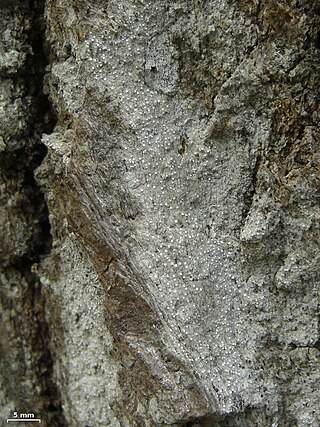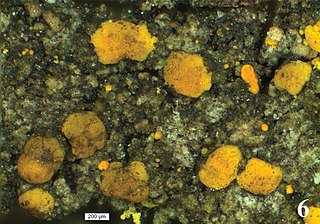
The Arthoniales is the second largest order of mainly crustose lichens, but fruticose lichens are present as well. The order contains around 1500 species, while the largest order with lichenized fungi, the Lecanorales, contains more than 14000 species.

The Arthoniaceae are a family of lichenized, lichenicolous and saprobic fungi in the order Arthoniales. The Arthoniaceae is the largest family of Arthoniales, with around 800 species. Most species in Arthoniaceae belong in Arthonia which is the largest genus with 500 species. The second and third largest genus is Arthothelium with 80 species, and Cryptothecia with 60 species.

Felipes is a genus of lichenized fungi in the order Arthoniales. Circumscribed by Andreas Frisch and Göran Thor in 2014, it contains the single species Felipes leucopellaeus. Genetic analysis shows that the genus falls into the order Arthoniales, but its familial placement is uncertain. Felipes leucopellaeus is found across Europe and North America in temperate and boreal regions, typically in old-growth forest or wooded mires. It is crustose and corticolous.
Punctelia subpraesignis is a species of foliose lichen in the family Parmeliaceae. It occurs in Mexico, South America, and East Africa, where it grows on bark and on rocks. Major characteristics of the lichen that distinguish it from other Punctelia species include the C+ and KC+ rose spot tests of the medulla, ascospores that are smaller than 20 μm, and unciform (hooklike) conidia.
Myriostigma is a genus of lichens in the family Arthoniaceae. The genus was circumscribed by German lichenologist August von Krempelhuber in 1874.
Inoderma sorediatum is a species of crustose lichen in the family Arthoniaceae. It is only known to occur on the bark of trees in Poland's Białowieża National Park. It is differentiated from other species in genus Inoderma by the form of its thallus, which is entirely made of powdery, granular soredia, as well as by the presence of a unique combination of lichen products.
Lecanora helmutii is a rare species of corticolous (bark-dwelling), crustose lichen in the family Lecanoraceae. Found in Tasmania, it was formally described as a new species in 2018 by Sergio Pérez-Ortega and Gintaras Kantvilas. The type specimen was collected from the eastern side of Stanley Highway, where it was found growing on the bark of Banksia marginata in a coastal swampy woodland dominated by Melaleuca. It is only known from the type collection. Other associated lichens include Austroparmelina pseudorelicina, Bactropsora paludicola, Menegazzia subpertusa, Pannaria elixii, and Parmotrema perlatum. The species epithet honours Austrian lichenologist Helmut Mayrhofer.
Amazonotrema is a monotypic genus of lichenised fungi in the family Graphidaceae. It was circumscribed in 2009 by Klaus Kalb and Robert Lücking for the species Amazonotrema nigrum. The type specimen of A. nigrum was collected from virgin rainforest along the Rio Negro in the Brazilian state of Amazonas.
Pseudochapsa lueckingii is a species of corticolous (bark-dwelling), crustose lichen in the family Graphidaceae. It is known only from a single collection in São Paulo, Brazil.

Biatora pontica is a species of corticolous (bark-dwelling), leprose lichen in the family Ramalinaceae. It is a widely distributed species, having been recorded in Africa, Asia, Europe, and North America.
Maronora is a monotypic fungal genus in the family Fuscideaceae. It contains the single species Maronora cyanosora, a corticolous (bark-dwelling) lichen. It is characterised by its distinctive bluish-grey circular soralia on the thallus, Lecanora-like apothecia, and simple, hyaline ascospores.

Sporodophoron is a genus of lichen-forming fungi in the family Arthoniaceae. It includes four corticolous (bark-dwelling) crustose lichen species. Sporodophoron is uniquely characterised by the formation of fruiting structures called sporodochia, which are open conidiomata in the form of tufts of conidiophores on the thallus. Although these lichens bear a strong resemblance to Inoderma, another genus within the same family, Sporodophoron's distinct chemical makeup sets it apart from its lichen relatives. Collectively, the genus has a widespread geographical distribution in the Northern Hemisphere, with species found in distinct habitats in North America, Europe, Japan, and the Russian Far East.

Protocandelariella is a genus of lichen-forming fungi in the family Candelariaceae. It has two species of squamulose (scaley), corticolous (bark-dwelling) lichens.

Coniocarpon is a genus of lichen-forming fungi in the family Arthoniaceae. It has eight species of corticolous (bark-dwelling) lichens. This genus is distinct for its crystalline orange, red, and purple quinoid pigments in the ascomata that turn purple in potassium hydroxide solution, its colourless, transversely septate ascospores with large apical cells, and its rounded to lirellate ascomata.
Rinodina densisidiata is a little-known species of corticolous (bark-dwelling), crustose lichen in the family Physciaceae, first described in 2018. Found in Brazil, it is characterised its dense layer of cylindrical isidia and unique ascospore characteristics.
Rinodina maronisidiata is a species of corticolous (bark-dwelling), crustose lichen in the family Physciaceae, first described in 2018. Found at high altitudes in the Venezuelan Andes, it is characterised by its unique isidia-covered thallus and specific ascospore morphology.

Flavoplaca oasis is a species of saxicolous (rock-dwelling), crustose lichen in the family Teloschistaceae. It is widely distributed across Europe, and has been reported in Western Asia, China, and North Africa.

Glaucomaria is a genus of lichen-forming fungi in the family Lecanoraceae. It has seven species. The genus was circumscribed by Maurice Choisy in 1929. It contains crustose lichens formerly placed in the Lecanora rupicola species complex as defined by several previous authors.
Marchantiana occidentalis is a species of corticolous and saxicolous, crustose lichen in the family Teloschistaceae. It is found in Western Australia, usually as an inhabitant of dry twigs, bark, or wood of various plant species, but occasionally on granite rock outcrops. It forms a well-developed thallus, shiny and composed of tiny dark greenish to brown areoles, with sizes typically ranging from 5–15 mm, though larger aggregations are possible. It features numerous rounded apothecia scattered across its surface, varying in form and colour, with a distinct margin and disc.








